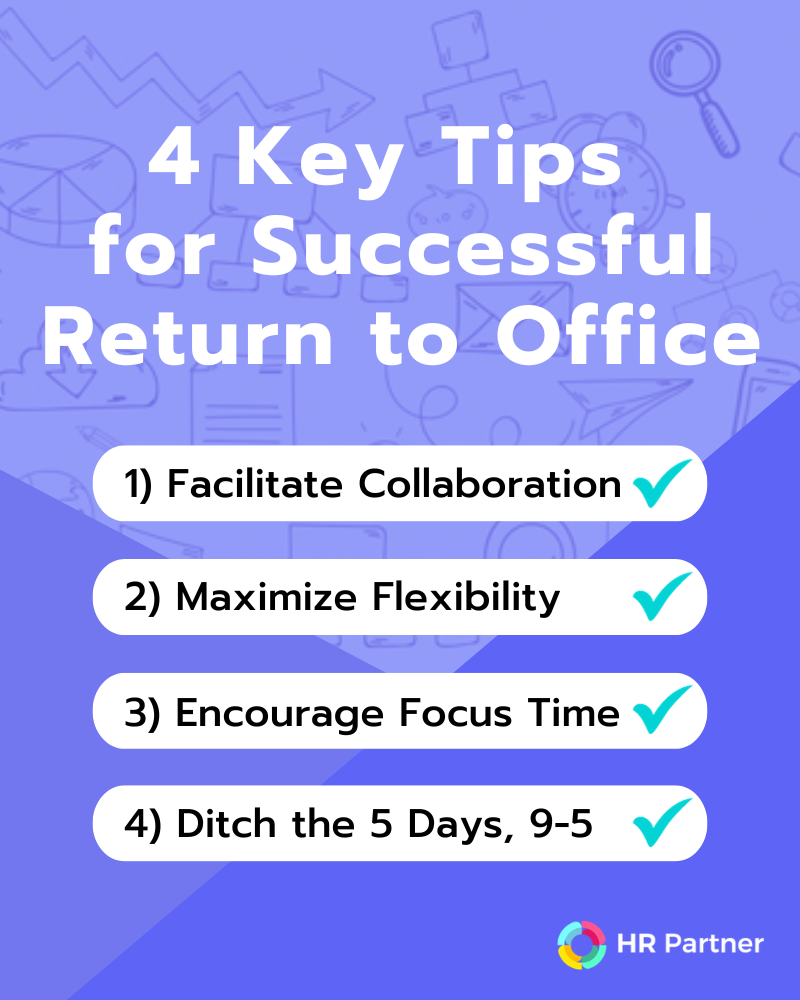It can be hard to navigate the “new normal” as we adapt further into a post-pandemic world. As companies contemplate the transition back to physical offices, HR professionals and business leaders have the challenging task of determining what will work best for their workforce. While some companies might benefit from in-person collaboration, others could find that their teams are just as efficient—or even more so—working remotely. With so many options now available, the question looms for many businesses: “What’s next for our workplace?”
Return-to-Office (RTO) stories are certainly all over the headlines at the moment, with companies such as Facebook, Google, Amazon, and even Zoom all requiring that their employees work from their offices at least part of their week. And a report from ResumeBuilder.com has found that nine in 10 organisations will have some form of an RTO policy by the end of 2024.
But decisions around returning to the office are anything but straightforward. They require a delicate balance between embracing the need for collaboration, respecting the conveniences of remote work, and fostering employee well-being. Here are two steps to help you evaluate if a return to office is a good fit for your workforce and how to best communicate the change:
Step 1: Determine if Return to Office is Right for Your Workforce
The first step for any strategy should be identifying the ‘why’ behind it. Ground your strategy with a checklist to see what structure makes the most sense for your workforce today. Ask yourself these questions and write down the answers to discuss with your leadership team:
- Demographics: Are the majority of your employees keen on in-office interactions, or do they have family commitments that may favor remote work?
- Geographic Proximity: Is the commute to the office convenient for most employees? Are remote workers willing and able to relocate?
Work Nature: Do tasks require in-person teamwork and/or face-to-face client interactions? Do employees need specific office equipment for their role? - Employee Preferences: Have you gauged employee sentiment towards returning to the office? Would a more flexible approach to an in-office transition be well-received?
- Company Culture: Does your culture thrive better with in-person camaraderie, brainstorming, and activities? Or has flexibility become part of what makes your culture work?
- Cost Factor: Can the company maintain a physical office without compromising other resources? Does remote work yield cost savings and increased productivity?
Step 2: Implement Best Practices for Return to Office
If you do decide that a full or partial Return-to-Office is the best thing, recognize that change can be hard. So, how can HR professionals and business leaders manage this transition smoothly? Below are some best practices to guide your return-to-office strategy, ensuring you meet the needs of your employees without sacrificing productivity or corporate culture.

1. Set In-Office Parameters to Facilitate Collaboration
Coming back to a half-empty office isn’t beneficial for anyone. What’s the point of leaving the comfort of home if you’re not getting that face-to-face interaction? When planning a return to the office, the first order of business should be setting parameters around when the majority of the team should be present.
Plan to have specific days, work hours, or events (such as team meetings) that employees are required to be in the office. If your organization downsized its physical space, a rotational in-office schedule for different departments or teams can also maximize the utility of a smaller office. This will help foster an atmosphere conducive to brainstorming, team meetings, and spontaneous collaboration, without the burnout or resentment of unproductive time in the office.
2. Maximize Flexibility Wherever Possible
The last couple of years have showcased the value of work-life balance more than ever. The COVID-19 pandemic has made flexibility an employee expectation, not a perk.
As your team returns to the office, be as flexible as possible to accommodate various needs—whether it’s flexible hours, remote days, or partial in-office attendance. This not only enhances employee wellbeing but also helps in retaining and attracting top talent.
3. Encourage Deep Work & Focus Time
In a world filled with digital distractions, the opportunity for deep work—uninterrupted, focused time—is increasingly valuable. If your strategy includes partial in-office days, make them count for collaborative activities like team meetings, client presentations, and project discussions.
On the other hand, reserve remote workdays for tasks that require deep concentration. If possible, maintain a meeting-free zone in the calendar during work-from-home days.
4. Most of All, Ditch the 9-5, 5 Days a Week Model
The “nine to five, five days a week” model is slowly becoming a thing of the past. Modern work environments are leaning towards flexible approaches that respect individual preferences while maintaining a cohesive team dynamic. As HR professionals, it’s your job to create a work setting that is adaptive, supportive, and sustainable for everyone involved, while also being productive and profitable.
A hybrid approach that incorporates both in-person and remote work can cater to the diverse needs and preferences of your workforce. It respects individuality while maintaining a cohesive team dynamic. If you believe 100% in-office is the best approach for your business, try to incorporate flexibility by only requiring certain hours of the day or events to be met.
…….
Transitioning back to the office is a journey, not a race. By implementing these best practices, you aren’t just navigating a transition; you’re setting a precedent for the future of work in your company. Remember, this isn’t about returning to what was considered “normal” before 2020; it’s about defining a new normal that works best for everyone. When both employers and employees have the flexibility and support to thrive, the entire organization benefits.

Amanda Rivera
HR Knowledge Navigator

